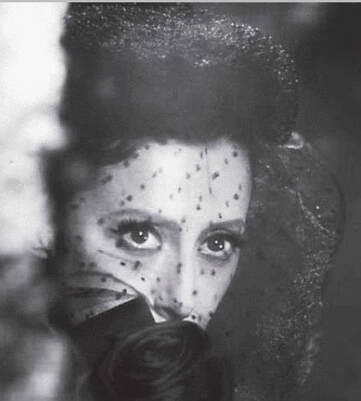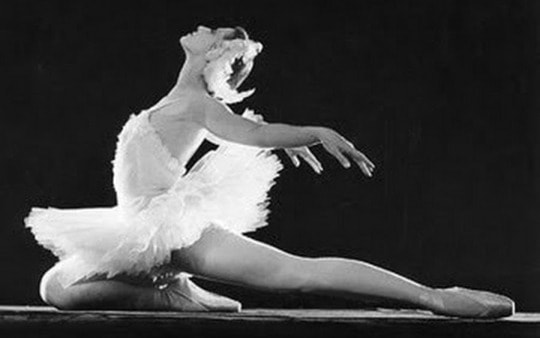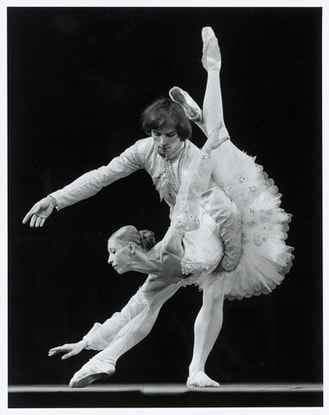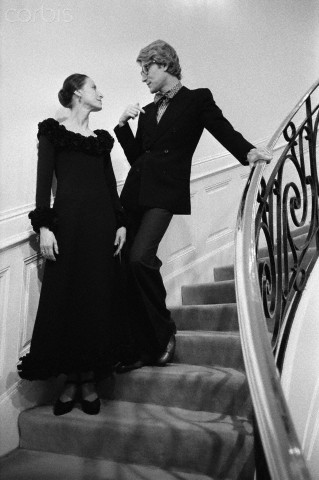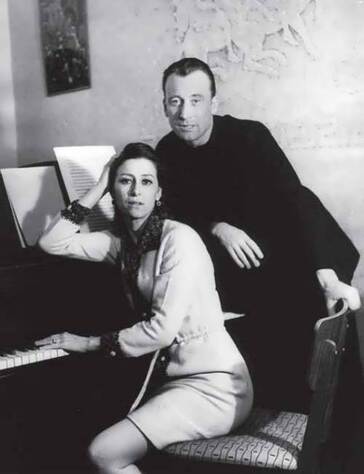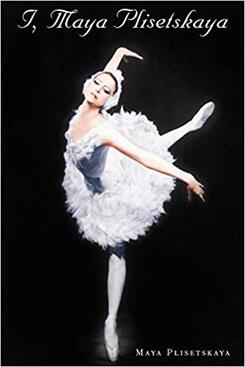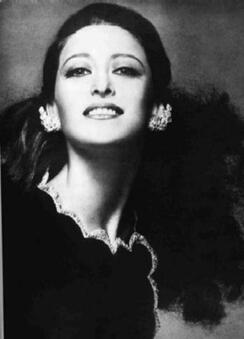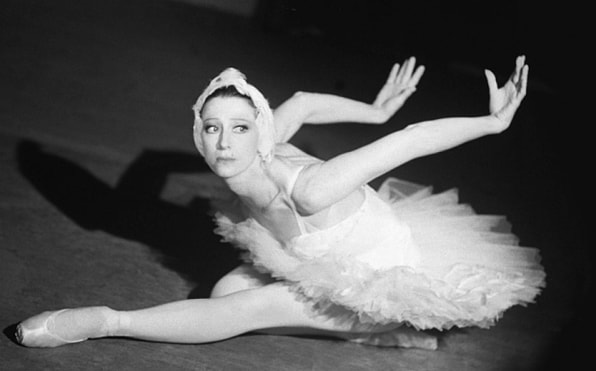|
Maya Mikhailovna Plisetskaya (20 November 1925 – 2 May 2015) was a Soviet ballet dancer, choreographer, ballet director, and actress. In post-Soviet times, she held both Lithuanian and Spanish citizenship. She danced during the Soviet era at the Bolshoi Theatre under the directorships of Leonid Lavrovsky, then of Yury Grigorovich; later she moved into direct confrontation with him. In 1960 when Galina Ulanova, another famed Russian ballerina retired, Plisetskaya became prima ballerina assoluta of the company. Her early years were marked by political repression and loss. Her father Mikhail Plisetski, a Soviet official, was arrested in 1937 and executed in 1938, during the Great Purge. Her mother actress Rachel Messerer was arrested in 1938 and was imprisoned for a few years, then held in a concentration camp together with her infant son. Maya was adopted by their aunt Sulamith Messerer, principal dancers of the Bolshoi. Plisetskaya studied ballet at The Bolshoi Ballet School from age nine, and she first performed at the Bolshoi Theatre when she was eleven. She studied ballet under the direction of Elizaveta Gerdt and also her aunt, Sulamith Messerer. Graduating in 1943 at the age of eighteen, she joined the Bolshoi Ballet company, quickly rising to become their leading soloist. As a soloist, Plisetskaya created a number of leading roles, including Juliet in Lavrovsky’s Romeo and Juliet; Phrygia in Yakobson’s Spartacus (1958); in Grigorovich’s ballets: Mistress of the Copper Mountain in The Stone Flower (1959); Aurora in The Sleeping Beauty (1963); Mahmene Banu in The Legend of Love (1965); Alberto Alonso’s Carmen Suite (1967), written especially for her; and Maurice Bejart’s Isadora (1976). As an artist she had an inexhaustible interest in new roles and dance styles, and she liked to experiment on stage. Among her most acclaimed roles were Kitri in Don Quixote, Odette-Odile in Swan Lake and The Dying Swan. Her interpretation of The Dying Swan, a short showcase piece made famous by Anna Pavlova, became her calling card. Plisetskaya was known for the height of her jumps, her extremely flexible back, the technical strength of her dancing, and her charisma. She excelled both in adagio and allegro, which is very unusual in dancers. Despite her acclaim, Plisetskaya was not treated well by the Bolshoi management and she was not allowed to tour outside the country for sixteen years, concerning about her defection due to her family history. Then in 1959, Plisetskaya wrote to the Soviet Premier Nikita Khrushchev “a long and forthright expression of her patriotism and her indignation that it should be doubted.” and he finally decided to lift her travel ban. Since then, for the next 3 decades, with the international exposure she long deserved, Maya Plisetskaya changed the world of ballet. She set a higher standard for ballerinas, both in terms of technical brilliance and dramatic presence. After performing in Spartacus during her 1959 U.S. debut tour, Maya Plisetskaya was rated second only to Galina Ulanova by Life magazine in its issue featuring the Bolshoi. And Spartacus became a significant ballet for the Bolshoi, with one critic describing their "rage to perform", personified by Plisetskaya as ballerina, "that defined the Bolshoi." With just a few years of travelling outside Russia, Maya Plisetskaya became “an international superstar” and a continuous “box office hit throughout the world,” and she was treated by the Soviet Union as a favoured cultural emissary. Although she toured extensively during the same years that other prominent dancers defected, including Rudolf Nureyev, Natalia Makarova, and Mikhail Baryshnikov, Plisetskaya always return to Russia. Fashion designers Yves Saint Laurent and Pierre Cardin considered Plisetskaya one of their inspirations, with Cardin alone having traveled to Moscow over 30 times just to see Plisetskaya perform, and she credits Cardin's costume designs for the success and recognition she received for her ballets of Anna Karenina(1974), The Seagull (1980), and Lady with the Lapdog(1985). Plisetskaya recalls Cardin's reaction when she initially suggested he design one of her costumes: "Cardin's eyes lit up like batteries. As if an electrical current passed through them." Within a week Cardin had created a design for Anna Karenina, and over the course of her career he created ten different costumes for just Karenina. Maya Plisetskaya married composer Rodion Shchedrin in 1958, who later wrote many music scores for her ballets, such as Carmen Suite created by Cuban choreographer Alberto Alonso in 1966, and later Anna Karenina(1974), The Seagull (1980), and Lady with the Lapdog(1985) seperately. In the 1980s, Plisetskaya and her husband Shchedrin spent time abroad extensively, where she worked for some of the world's most important ballet companies. In 1983–84, She was ballet director of the Rome Opera, and from 1987 to 1990, she was artistic director of Ballet del Teatro Lirico Nacional in Madrid. In 1990, Maya Plisetskaya retired as a soloist for the Bolshoi at age 65 and the next year she published her autobiography, I, Maya Plisetskaya. Beginning in 1994, she presided over the annual international ballet competition in Saint Petersburg, called Maya. In 1996 she was named the President of the Imperial Russian Ballet, Moscow private dance company and danced the Dying Swan, her signature role, at a gala in her honour in St. Petersburg. During her long and successful career, Maya Plisetskaya had won the highest awards in Soviet Union, such as the Lenin Prize and three orders of Lenin. She was also awarded many times internationally: In France, she was decorated Chevalier of the Legion of Honour and a Commander of the Order of Arts and Letters, and made an honorary doctor of the Sorbonne University; In Spain, she was awarded the Prince of Asturias Award for the Arts in 2005 together with the Spanish ballerina Tamara Rojo, and then awarded the Spanish Gold Medal of Fine Art. And she was also awarded in other European countries like Lithuania and Poland. In 2006, Emperor Akihito of Japan presented her with the Praemium Imperiale, informally considered a Nobel Prize for Art. Maya Plisetskaya died in Munich, Germany, on 2 May 2015 from a heart attack. Plisetskaya was survived by her husband Rodion Shchedrin, and a brother, former dancer Azari Plisetsky, a teacher of choreography at the Béjart Ballet in Lausanne, Switzerland. According to her last will and testament, she was to be cremated, and after the death of her husband, who is also to be cremated, their ashes are to be combined and spread over Russia. Further reading Books 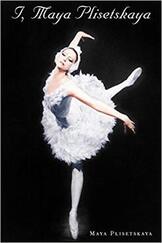 Maya Plisetskaya, one of the world’s foremost dancers, rose to become a prima ballerina of Moscow’s Bolshoi Ballet after an early life filled with tragedy and loss. In this spirited memoir, Plisetskaya reflects on her personal and professional odyssey, presenting a unique view of the life of a Soviet artist during the troubled period from the late 1930s to the 1990s. Plisetskaya recounts the execution of her father in the Great Terror and her mother’s exile to the Gulag. She describes her admission to the Bolshoi in 1943, the roles she performed there, and the endless petty harassments she endured, from both envious colleagues and Party officials. Refused permission for six years to tour with the company, Plisetskaya eventually performed all over the world, working with such noted choreographers as Roland Petit and Maurice Béjart. She recounts the tumultuous events she lived through and the fascinating people she met—among them the legendary ballet teacher Agrippina Vaganova, George Balanchine, Frank Sinatra, Rudolf Nureyev, and Dmitri Shostakovich. And she provides fascinating details about testy cocktail-party encounters with Khrushchev, tours abroad when her meager per diem allowance brought her close to starvation, and KGB plots to capitalize on her friendship with Robert Kennedy. Gifted, courageous, and brutally honest, Plisetskaya brilliantly illuminates the world of Soviet ballet during an era that encompasses both repression and cultural détente. Tim Scholl(co-author) is professor of Russian language and literature at Oberlin College. Antonina W. Bouis(translator) is the prize-winning translator of more than fifty books, including fiction, nonfiction, and memoirs by such figures as Andrei Sakharov, Elena Bonner, and Dmitri Shostakovich.
0 Comments
Leave a Reply. |
Categories
All
Archives
December 2023
|
